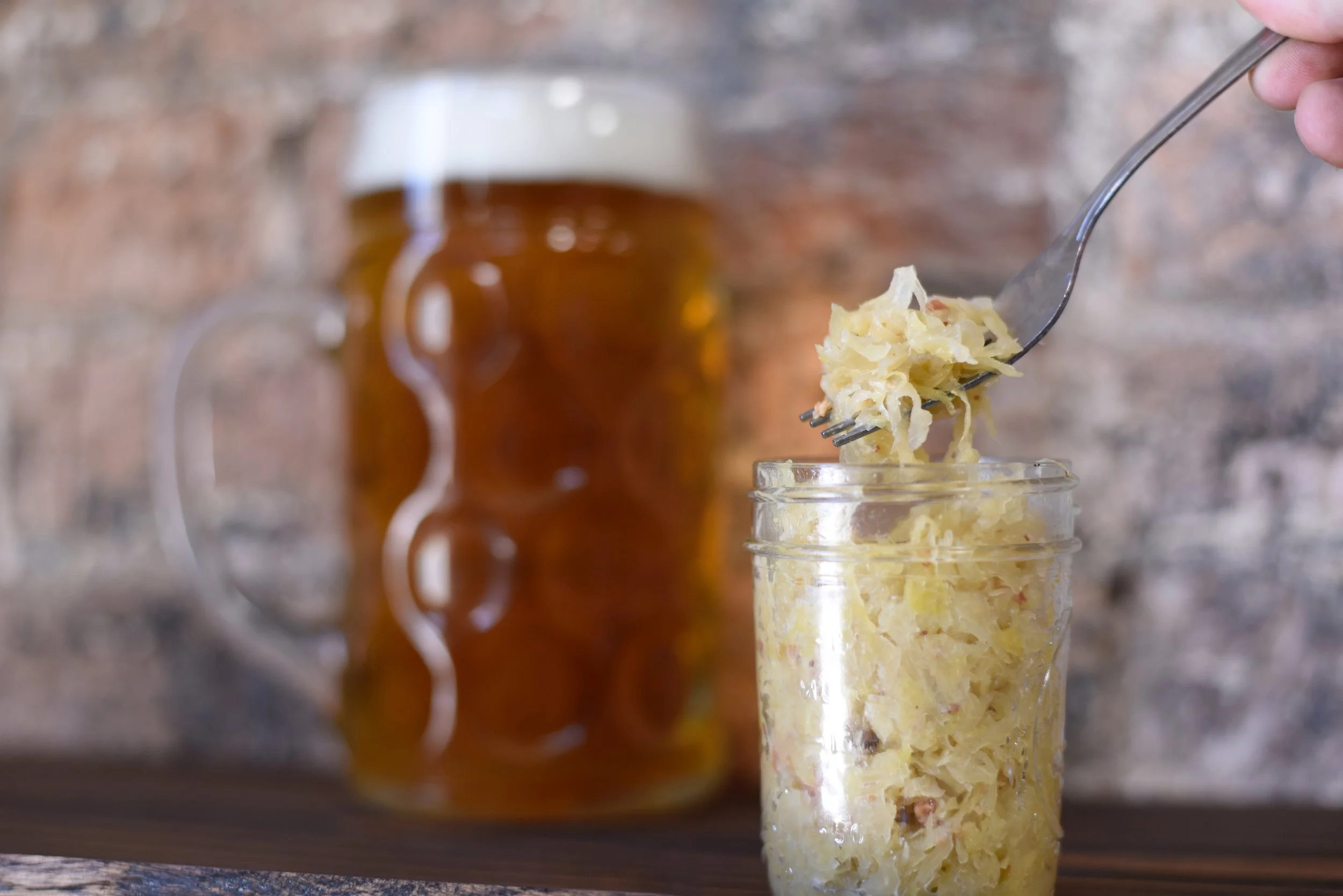8 Fermented Foods Recipes to Improve Gut Health Naturally
/It can be daunting to think about how to improve gut health naturally with fermenting foods from scratch, but don’t let that stop you from giving it a try! Fermented foods taste amazing and are fabulous for your health!
I’ve already written about fermented foods and how they provide beneficial bacteria, also known as probiotics, to restore gut health and support overall health. Now it’s time to switch gears and get you dabbling a bit.
Wondering where to start? I’ve got you covered with recipes that are simple and easy to prepare. In this blog article, I include 8 detailed recipes on how to ferment your own vegetables and one tasty recipe for a homemade fermented tea called Kombucha. If you’re ready to get started right now, scroll on down and browse through the recipes. If you want a bit more of an introduction to the how’s and why’s of fermented foods, stick with me right here.
Making your own fermented foods from scratch
Although fermented foods are readily available for purchase and wildly popular in grocery stores, making your own provides you the freedom to experiment with new flavors while giving you more bang for your buck.
If you’re in the same position as I am, with a garden that is abundant for a mere three months of the year and dormant for the remaining - fermenting is a great way to preserve the energy and nourishment of garden vegetables.
If you are new to fermenting foods, know that homemade fermented foods couldn’t be simpler and are well worth the short time they take to me. Trust me - fermenting is a whole lot less cumbersome than canning and provides a simple way to manage an abundant harvest.
Foods that can be fermented
Fruits and vegetables are the easiest foods to ferment. Examples of fruit and vegetable “ferments” include chutneys, jams, honey, ciders, sauerkraut, pickles, relishes, vinegar, root beer (think ginger beer!), and salsas.
Whole grains can also be fermented. Think sourdough, bread, crackers, and muffins.
To maximize the health benefits of your fermented products, choose local and seasonal whole foods. They will likely contain higher amounts of critical bioactives and minerals that are needed for your genes and the biological circuitry of your body to function. Choose local and seasonal foods that are grown without chemical products such as synthetic herbicides. Find them at your local farmers market, a food stand, or in your own garden.
Fermented foods worth mentioning
One of the most common and well known fermented foods is sauerkraut. It’s often paired with German bratwursts, but is easy to add as a condiment to any dish and is great with eggs. I promise! Unfortunately, many sauerkrauts found in the store are heat processed (pasteurized). Heat applications can destroy the probiotic bacteria that are at the beneficial heart of fermented foods. Therefore, making your own is a great option to consume the health benefits found in raw sauerkraut. And it is so easy to do! I call sauerkraut homemade medicine.
Now if you want to get super creative, try your hand at your own homemade sauerkraut, but perhaps grab a taste of two of these “small batch” sauerkrauts.
The second most common fermented food I see in stores is kombucha. Kombucha is easily available commercially but often higher in sugar than a homemade version. Homemade kombucha uses a kombucha culture known as a mushroom or mother. During the fermentation process, up to 1.5% of alcohol content is produced. Longer fermentation means higher alcohol content.
How to incorporate fermented foods
Upping the ante on fermented foods from every once in a while to daily can make a large impact on your health and influence how you feel. Not only will you increase the number of helpful bacteria in your gut but fermented foods also a nutrient tonic in and of themselves. You see the bacteria in fermented foods are not only capable of producing additional nutrients in their immediate food environment, but they can also break down destructive natural barriers in food, freeing nutrient elements that would otherwise be bound up, or unavailable. Nothing short of amazing right? I’ve included references to scientific papers at the end of this blog article if you’re interested in digging deeper into the nutritional value of fermented foods.
If you are wondering how to incorporated fermented vegetables to your diet, my best suggestion is to pair your ferments as a side dish. Here are some suggestions:
Add to grilled bratwursts or other protein of choice
Add on top of a mixed green salad or coleslaw
Layer it with your sandwich ingredients
Put into tacos or burritos
As a side with eggs
Mix in with stir-frys
Combine with other prepared vegetables
I talk about fermented foods in my upcoming book. Click on the image to be notified via our newsletter when my book is available!
Basic Fermentation Equipment
The good news is that you don’t need a bunch of expensive equipment or gadgets to produce your own fermented foods. After all, our ancestors have been fermenting food for years using very basic vessels. That being said, you do want to make sure you have the basic equipment on hand so that you get consistent quality fermented foods.
The Basics
I keep it super simple. I use glass mason jars with new covers and collars each time I ferment.
You can go even more basic than me and use a ceramic or glass vessel, even an original fermenting “crock.” Here’s a great tour of crocks and different fermentation vessels.
If you are using some kind of open crock or vessel
You’ll need a cover (you can use a clean towel). This prevents contamination for airborne particles, molds etc.
Some sort of weight (i.e. a plate, clean rock, or resealable plastic bag filled with water). This keeps your ingredients submerged in the brine or culturing medium which is essential to fermentation in an open vessel
Can’t be bothered with the old fashioned way, you can purchase fermentation jars with airlock kits. See here
Our 8 must-try fermented foods recipes
These recipes are our among our favorite as well as on our “must try” list. Give them a try and also check out our GK Enablers (E): Probiotic Rich Pinterest board for more inspiration! Don’t forget to scroll to the end of this blog article for more reading resources on fermented foods.
1.Sauerkraut using red cabbage By Side Walk Shoes
We love using red cabbage because of its vibrant color! It’s an easy fermented foods recipe to start off with for beginners. It requires only two ingredients - cabbage and salt!
A great tutorial on small batch sauerkraut making at home!
I love making kombucha. I regularly make my own concoction at home. Once you have a scoby, it only takes a week for your fermented tea to be ready!
You’re going to love this Fermented Asparagus Recipe!
Cauliflower is such a winner. Perhaps it’s because it doesn’t get as sour, even when fermented for a long time. Maybe because it stays crunchy without being hard. For the maker, it’s easy to boot – no kneading, grating, pounding, or thinly slicing. Just break or cut up the cauliflower, throw in a jar, and pour over a salt brine.
I love carrots! Now you can ferment carrots that will stay available throughout the winter that even your kids will eat!
A pretty pink recipe that is useful for the abundant radishes that can grow all season long.
Something new to try!
Learn more about fermented foods
1. Rezac S, Kok CR, Heermann M, Hutkins R. Fermented Foods as a Dietary Source of Live Organisms. Front Microbiol. 2018;9:1785.
2. Selhub EM, Logan AC, Bested AC. Fermented foods, microbiota, and mental health: ancient practice meets nutritional psychiatry. J Physiol Anthropol. 2014;33(1):2.
3. Marco M, et al. Health benefits of fermented foods: microbiota and beyond. Current Opinion in Biotechnology. 2017; 44. 94-102
Courses, Equipment and Cultures
www.bodyecology.com
www.culturesforhealth.com














